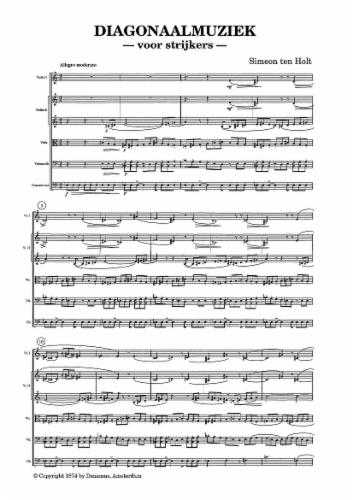Diagonaalmuziek

Program Note
The origin of Diagonaalmuziek voor strijkers ['Diagonal music for strings'] dates back to the 1950s, a period in which I, preoccupied with the question of tonality and the role of the tone centre, experimented with what I would call the 'diagonal-idea'.
In brief, this amounts to a procedure of arranging the twelve tones of the equal temperament according to their position on the circle of fifths instead of their being arranged according to series as in the sense of serialism.
From a compositional point of view, it was a matter of bitonality or polytonality, the basic assumption and guideline being the complementary tonalities or series within the circle of fifths such as, for instance, C-F sharp orA-E flat in the tritone proportion. The tone centre on one side of the circle would activate the tone centre on the opposite side, the light side being, as it were, connected with the dark side. The philosophical considerations which then played a role as an initial impetus and by-product cannot be discussed here. In the diagonal concept, the division of the tone centre into the equivalence of the additional function neighbouring opposite jeopardized its tonal main function. In real terms, this amounted, because of the tonality of the circle of fifths, to some form of twelve-tone music. This twelve-tone music, however, was as yet diatonic instead of chromatic as in serialism in which all tones would relate to each other instead of a tone centre.
In my creative career, the Diagonaalmuziek voor strijkers (1958) was the gate to an episode that banished the tone centre, culminating in the project Atalon (1968) which has a purely serial construction. Another decade later, this quest into a linguistic texture corresponding to the prerequisites of an inner world was, as is known, to lead to the restoration of tonality as well as of tones relating to a centre (Canto Ostinato e.g., 1979).
The circle graph below shows spatially the course in the time of the formal procedure in movement II (lento, sostenuto). The complement of the semicircles will occur through a cross which, after having made its round, returns to its original position. Each starting from their own positions on the crossmodel, the four parts of the composition (violoncellos and double basses share one part) pass through the circle's four quarters while modulating through the intermediate stations in such a way that the position of the cross will be mutually maintained by the respective modulations.
Part I modulating from C to G implies the other parts' positions being in C sharp, E and B flat respectively. The shift is synchronous. This way, all parts will pass through the tone positions of the circle until they have returned to their starting points. Accordingly, the composition has four movements (quarters) A, B, C and D. Movements A and D as well as B and C are thematically each other's mirror image, together forming a closed structure.
SIMEON TEN HOLT

